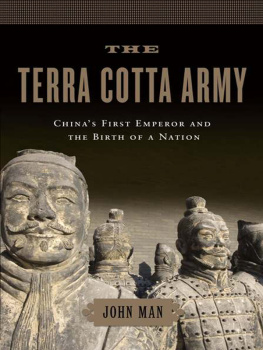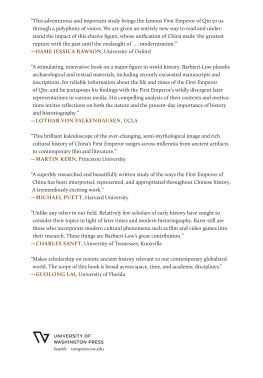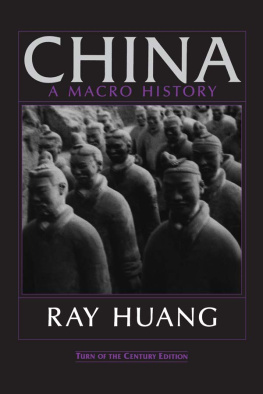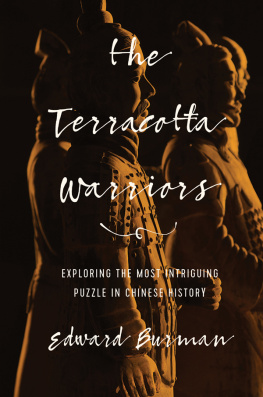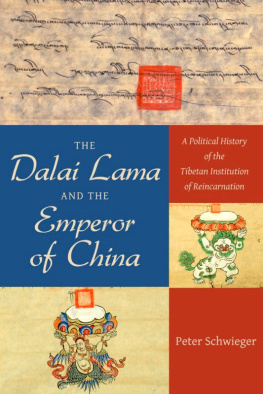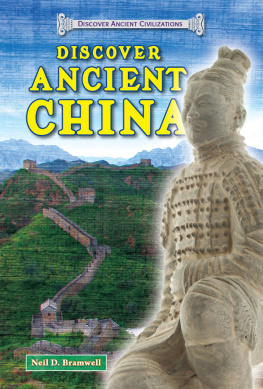Most Chinese words in this book are names, and all except for the occasional very well-established one are transliterated using the modern system, pinyin (as opposed to the old one, known as WadeGiles). In pinyin, most letters and diphthongs are roughly as in English, but some have their own pronunciation. These are the main ones:
Commonly, pinyin omits the tones, which helps define the Chinese character. In Mandarin, there are four tones, indicated with accents on the vowel (the first, in diphthongs):
Even so, pinyin cannot always specify the exact sign, so in cases of doubt or particular significance I add the Chinese signs; not, however, for proper names, which are generally well known to specialists and need neither tones nor signs to identify them.
ACKNOWLEDGEMENTS
Catharina Blnsdorf, Chair of Conservation, Technische Universitt, Munich; Pat Cox, former senior tutor, Fire Service College, Moreton-in-Marsh; Anne Cullen, London; Prof. Duan Qingbo, Director of Archaeology, Shaanxi Province; Vince Dunn, fire expert; Hu (Howard) Xiaojun, Intrepid Travel, Xian; Tom Jenen, Pharm; Miu Yee (Polly) Kwong; Joe Lally, fire expert, US Dept of Interior, Bureau of Land Management, Albuquerque, NM; Ningrui (Aileen) Ren; Helen Tang, SOAS; Jin Kai, Terra Cotta Army Museum; Li Bin, Cultural Affairs Bureau, Xian; Li Junyi, Jerry Wong and Cha Hai Bo (Charlie), Xian Ceramics and Lacquer Factory; Li Naifu, Xian Architecture and Technology University; Stephanie Lin Feng (Manager) and Anthony Lee (my terrific guide), Xian Everbright International Travel Service, Xian; Maggie, Huaqing Aegean International Hot Springs Resort, Lintong; Ma Yu, Restoration Dept, Terra Cotta Army Museum; Nin Shodo, Grandmother Temple, Mount Li; Niu Xinlong, Stone Armour Archaeology Team, Terra Cotta Army Museum, Lintong; Jane Portal, British Museum, London; James Quintire, fire expert and author of Principles of FireBehaviour; Wang Tao, SOAS; Wang Lianyuan, Qin-Style Eighth Wonder Reproduction Factory, Beitian; Wang Zhan, monumental sculptor, Xian; Wang Qinren and Yi Xiaoqiang, China Youth Press, Beijing; Wang Zhigao, the best of drivers; Pablo Wendel, performance artist, Stuttgart; Bob Wyllie, Fire Service College, Moreton-in-Marsh; Yang Shuanshuan, Xi Yang village; Yang Zhefa, Terra Cotta Army Museum; Yuan Zhongyi, former President, Terra Cotta Army Museum, Lintong; Zhang Hui (Roy), Xian; Zhao Kangmin, Lintong; Zhong Tangyan, Xian Centre, China Geological Survey. And on the production of this book: Doug Young, Simon Thorogood and Sheila Lee at Transworld; Gillian Somerscales, for superb editing; Malcolm Swanston and Jonathan Young, Red Lion Mapping; and, as always, Felicity Bryan and her wonderful staff.
PICTURE ACKNOWLEDGEMENTS
All the photographs were taken by the author except for the following:
FIRST SECTION
Pages 23 Present-day view of the tomb-mound: Terra Cotta Army Museum; photograph taken by Victor Sgolen, 16 February 1914, now in the Muse Guimet, Paris: Photo RMN- Richard Lambert.
Pages 45 Still from The Curse of the Golden Flower: Rex Features/ Sony Pics/Everett.
Pages 67 Kneeling figure: Terra Cotta Army Museum; excavations 31 October 1975: AP/PA Photos.
Pages 89 Pit No. 1, general view: Terra Cotta Army Museum.
Pages 1011 All photos except for restoration shot: Terra Cotta Army Museum.
Pages 1213 Pit No. 2, general view, archer and polychrome head: Terra Cotta Army Museum; Pit No. 3: Zeng Nian/Gamma/Camera Press London.
Pages 1415 Pit No. 2, archers and restoration in situ: Terra Cotta Army Museum.
Page 16 General from Pit No. 2: Terra Cotta Army Museum; reconstruction: Hardlines.
SECTION TWO
Page 17 Official and detail: Terra Cotta Army Museum.
Pages 1819 Various figures, top left, centre bottom, Terra Cotta Army Museum; bottom left, top right, centre right and bottom right: akg-images/Laurent Lecat.
Pages 201 All photos: Terra Cotta Army Museum.
Pages 223 Chariot: www.araldodeluca.com.
Pages 267 Entertainer: Terra Cotta Army Museum.
Pages 301 Tomb reconstruction: Duan Qingbo.
Page 32 Performance by Pablo Wendel: Brouwer-Editions.
PREFACE: AN ARMY OF THE PAST AND PRESENT
The Terra Cotta Army attracts clichs as light attracts moths, and none of them do it justice. There is a nobility in the serried ranks of warriors, in the hint of a smile here, the gravity of a glance there, the patience with which they await orders, their Confucian aura of strength and tranquility. Part of the impact made by those ranked figures comes from the gut feeling that they are the guardians of hidden universes of artistry, organization, religious and historical significance, and raw power.
All these lead back to one man, the First Emperor, the man who turned a China of warring states into the core of todays single nation. It was an astonishing achievement by one of historys towering personalities, a man who combined vision, leadership and utter ruthlessness to force unwilling rivals together. Even more astonishing, it was all done in under ten years (230221 BC), a decade which many believe to be the most significant in Chinas 5,000 years of history. The First Emperor took a vague sense that unity was a good idea, and thrashed it into an ideal that has anchored China to this day.
Unity, character, the Army, the vast tomb-mound and the body it contains: these elements are inseparable. Without the First Emperors skills, there would be no unity; without unity, no organization, no industrial-scale artistry, no tomb-mound, no need for a spirit army at all.

